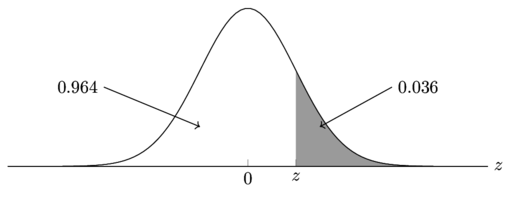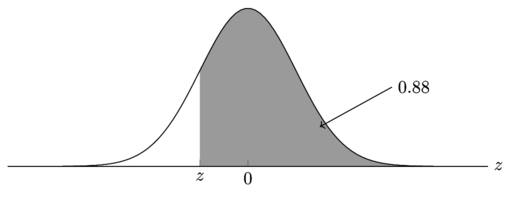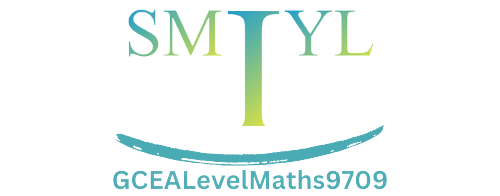5.5.2 Finding Mean and Standard Deviation
In this topic we will learn how to
- solve problems concerning a variable X, where X \sim N(\mu, \sigma^{2}), including finding a relationship between x_{1}, \mu and \sigma given the value of P(X > x_{1}) or a related probability
There are questions where you will be asked to evaluate \mu, \sigma or both. In those questions, you have to use the given information to find the unknown(s).
Let’s walk through some past paper questions to better understand this idea.
1. The weights of bags of sugar are normally distributed with mean 1.04 kg and standard deviation \sigmakg. In a random sample of 2\ 000 bags of sugar, 72 weighed more than 1.10 kg. Find the value of \sigma. (9709/52/M/J/21 number 2)
Define the random variable,
X\textmd{ - r.v, weights, in kg, of bags of sugar}State the distribution and parameters of the random variable,
X \sim N(1.04, \sigma^{2})Let’s write out, mathematically, the information we have been given in the question,
P(X > 1.10) = \frac{72}{2\ 000}We can use this to find \sigma. Let’s simplify,
P(X > 1.10) = 0.036Let’s standardize,
P\left(Z > \frac{1.10 - 1.04}{\sigma}\right) = 0.036Let’s replace \frac{1.10 - 1.04}{\sigma} with z for better readability,
P(Z > z) = 0.036

From the diagram, we can tell that z is going to be positive. Since 0.036 is less than 0.500 let’s subtract it from 1,
1 - 0.036 = 0.964Let’s use the tables in reverse to find z,
z = \phi^{-1}{\left(0.964\right)}z = 1.798Note: The notation \phi^{-1}{(a)} means we’re using the tables in reverse.
Now that we have found z, we can find \sigma,
z = \frac{1.10 - 1.04}{\sigma}1.798 = \frac{0.06}{\sigma}\sigma = \frac{0.06}{1.798}\sigma = 0.03337041157Give your answer correct to 3 significant figures,
\sigma = 0.0334Therefore, the final answer is,
\sigma = 0.03342. The systolic blood pressure (SBP) of 12-year old children is normally distributed with mean 117. Of these children 88\% have SBP more than 108. (9709/51/O/N/22 number 4)
Define the random variable,
X \textmd{- r.v, SBP of }12\textmd{-year-old children}State the distribution and parameters of the random variable,
X \sim N(117, \sigma^{2})Let’s write out, mathematically, the information we have been given in the question,
P(X > 108) = 0.88Let’s standardize,
P\left(Z > \frac{108 - 117}{\sigma}\right) = 0.88Let’s replace \frac{108 - 117}{\sigma} with z for better readability,
P(Z > z) = 0.88

From the diagram, we can tell that z is going to be negative.
Let’s use the tables in reverse to find z,
z = \phi^{-1}{(0.88)}z = 1.175Remember that our z-value is supposed to be negative,
z = -1.175Now that we have found z, we can find \sigma,
z = \frac{108 - 117}{\sigma}-1.175 = \frac{108 - 117}{\sigma}\sigma = \frac{-9}{-1.175}\sigma = 7.659574468Give your answer correct to 3 significant figures,
\sigma = 7.66Therefore, the final answer is,
\sigma = 7.663. The lengths of the leaves of a particular type of tree are modelled by a normal distribution. A scientist measures the lengths of a random sample of 500 leaves from this type of tree and finds that 42 are less than 4 cm long and 100 are more than 10 cm long. Find estimates for the mean and standard standard deviation of the lengths of the leaves from this type of tree. (9709/53/M/J/21 number 5)
Define the random variable,
X \textmd{- r.v, lengths, in cm, of leaves of a particular type of tree}State the distribution and parameters of the random variable,
X \sim N(\mu, \sigma^{2})Let’s write out, mathematically, the information we have been given in the question,
P(X < 4) = \frac{42}{500}\ \ \ \ \ \ P(X > 10) = \frac{100}{500}We can use this information to form two simultaneous equations, in terms of \mu and \sigma. Let’s simplify,
P(X < 4) = 0.084\ \ \ \ \ \ P(X > 10) = 0.20Let’s standardize,
P\left(Z < \frac{4 - \mu}{\sigma}\right) = 0.084\ \ \ \ \ \ P\left(Z > \frac{10 - \mu}{\sigma}\right) = 0.20Let’s substitute \frac{4 - \mu}{\sigma} and \frac{10 - \mu}{\sigma}, with z_{1} and z_{2} respectively for better readability,
P(Z < z_{1}) = 0.084\ \ \ \ \ \ P(Z > z_{2}) = 0.20

From the diagrams, we can tell that z_{1} is going to be negative and z_{2} is going to be positive.
Let’s use the tables in reverse to find z,
z_{1} = \phi^{-1}{(0.916)}\ \ \ \ \ \ z_{2} = \phi^{-1}{(0.80)}z_{1} = 1.378\ \ \ \ \ \ z_{2} = 0.842Remember that z_{1} is supposed to be negative,
z_{1} = -1.378\ \ \ \ \ \ z_{2} = 0.842Now let’s go back to the expressions for z_{1} and z_{2} from earlier,
z_{1} = \frac{4 - \mu}{\sigma}\ \ \ \ \ \ z_{2} = \frac{10 - \mu}{\sigma}Substitute z_{1} and z_{2} respectively,
-1.378 = \frac{4 - \mu}{\sigma}\ \ \ \ \ \ 0.842 = \frac{10 - \mu}{\sigma}Make both equations linear,
-1.378\sigma = 4 - \mu \ \ \ \ \ \ \ \ 0.842\sigma = 10 - \muNow solve the two equations simultaneously, to evaluate both \mu and \sigma,
-1.378\sigma = 4 - \mu \ \ \ \ \ \ \ \ 0.842\sigma = 10 - \mu\mu = 4 + 1.378\sigma0.842\sigma = 10 - \mu0.842\sigma = 10 - (4 + 1.378\sigma)0.842\sigma = 10 - 4 - 1.378\sigma0.842\sigma = 6 - 1.378\sigma0.842\sigma + 1.378\sigma = 62.22\sigma = 6\sigma = 2.702702703\mu = 4 + 1.378\sigma\mu = 4 + 1.378(2.702702703)\mu = 7.724324324Give your answers correct to 3 significant figures,
\sigma = 2.70 \ \ \ \ \mu = 7.72Therefore, the final answer is,
\sigma = 2.70 \ \ \ \ \mu = 7.72
